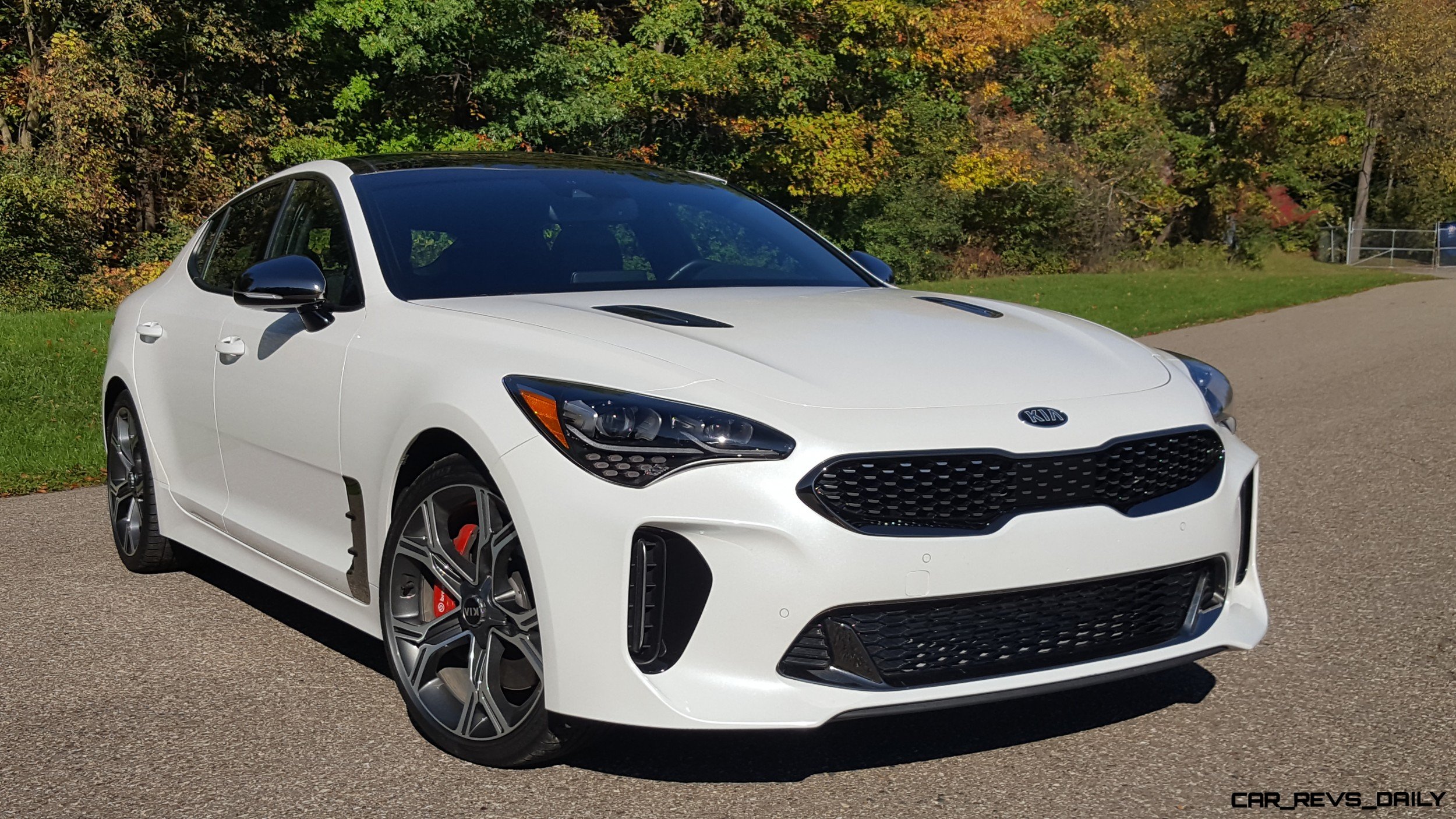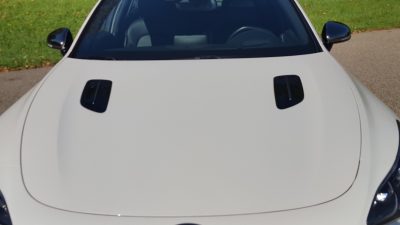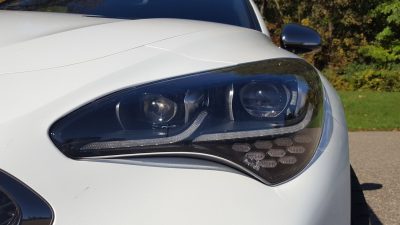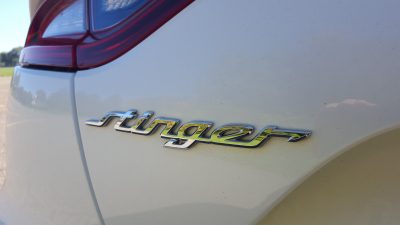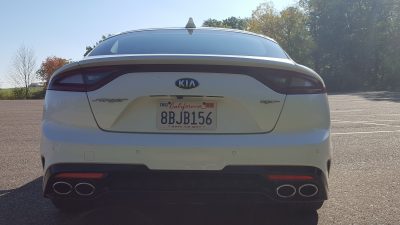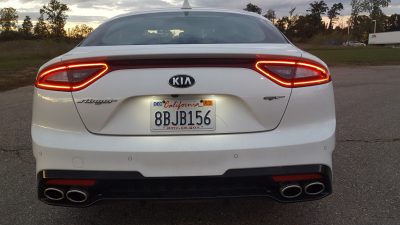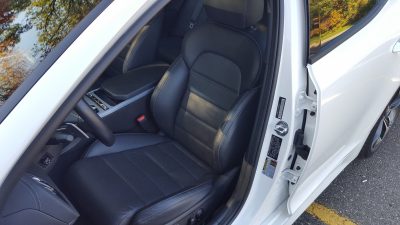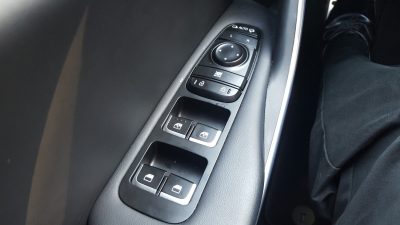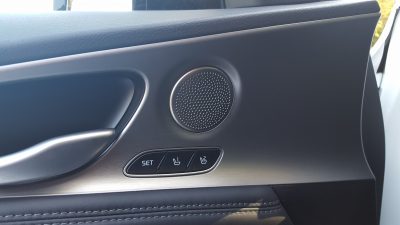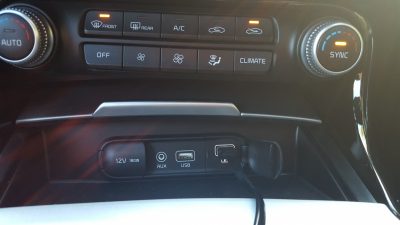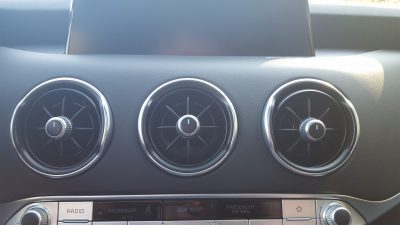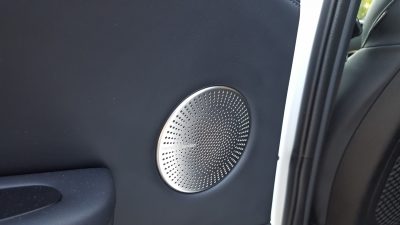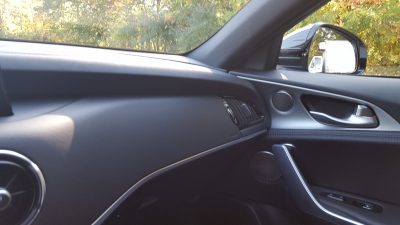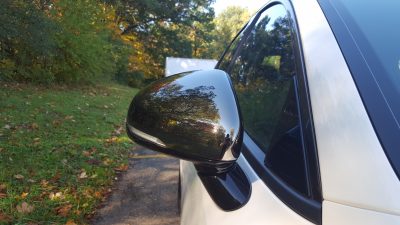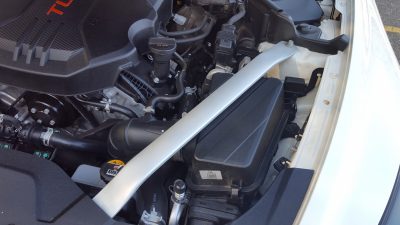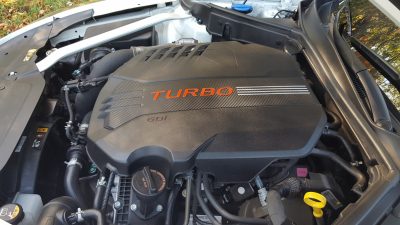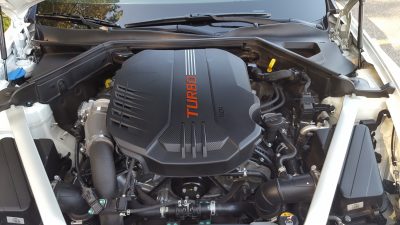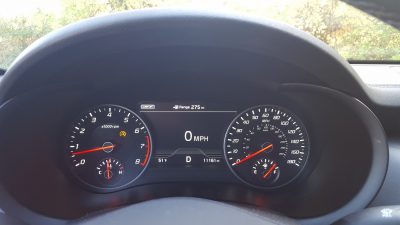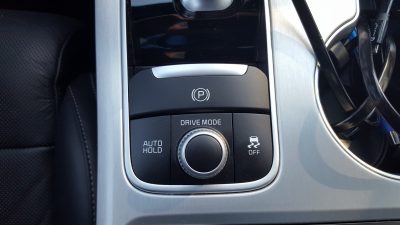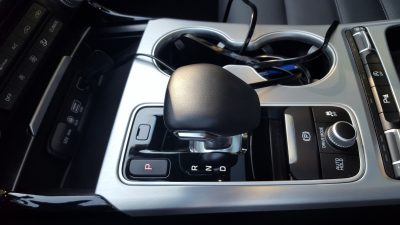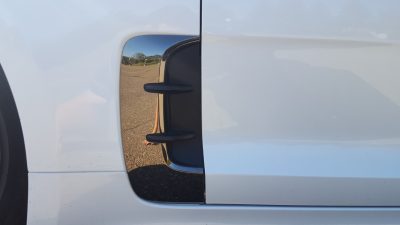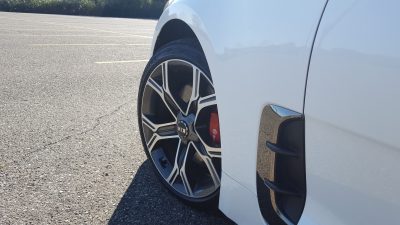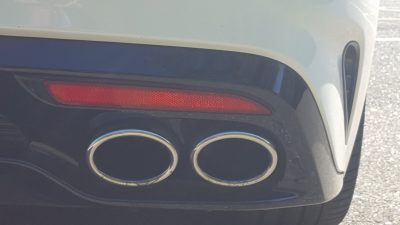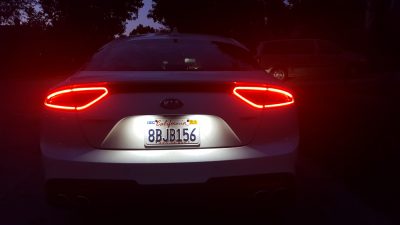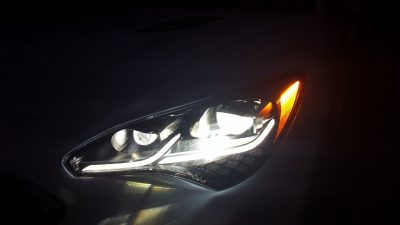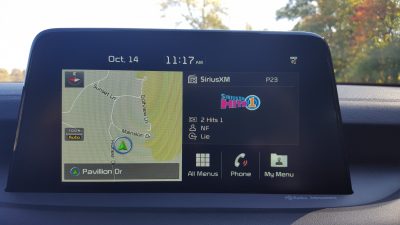When we last had the chance to meet the Kia Stinger at the Car-Revs-Daily Metro Detroit outpost, it was in its base four cylinder form. The four cylinder Stinger aimed to deliver enthusiasts a package that infused some of the Stinger’s driving charms, with the fuel economy that is quickly becoming a crucial piece of the automotive puzzle. Our tester at the time proved to be a solid all-rounder, but we made a note to try and check out its spicier cousin, the GT Stinger. After a brief sampling on an autocross track in northern Wisconsin this summer, we finally had our chance earlier this fall. But can the GT transform the Stinger into a truly perfect bargain purchase for the budget minded enthusiast? Or does it fall short of beating the benchmark that has long been occupied by German entries such as the BMW 3-Series, Audi A4, and the Mercedes C-Class?
Polished Style and Upscale Ambitions:
To find out, we spent a week with the GT2 variant, and put it through its paces in various forms of driving. The GT2 model is the range topping Stinger in the lineup, and our Snow White Pearl hued tester brings a number of minor updates to make itself stand out from its lesser GT and GT1 siblings. Before we get into the finer details on that front, lets focus on the bold exterior styling that is visually apparent here on the GT range. Kia designers wanted to make the Stinger look purposeful and aggressive, and GT grade cars take this philosophy to heart.
Unlike more mainstream Stinger models, GT models feature beefy 19-inch alloy wheels, LED headlights, as well as Brembo brakes with bright red brake calipers. These touches work hand in hand with the rest of the exterior styling, and give the Stinger a muscular look that also highlights its track focused intentions loud and clear. Like others of its breed, the hatchback-esque layout of the Stinger does its best to deliver maximum levels of versatility, but the big trunk lid can be hard to close for shorter drivers, and the sloping roof line does eat into cargo space slightly.
As expected, quad exhaust tips and the distinctive GT badges round out the rear fascia, and the balanced look overall is a rare thing to see in many sedan entries. While the Dodge Charger does one up the Stinger in brutish aesthetics, and retro inspiration. The sleek Korean makes up for it by bringing more detail, polish, and distinction to its visual identity, and that puts it in the hunt with rivals such as the BMW 4-Series Gran Coupe, as well as the Audi A5 Sportback.
Sacrificial Lamb:
As expected, the Stinger’s value focused mission does require a few sacrifices to be made, and the bulk of them can be found in its cheap looking interior. The Nappa leather sport seats that adorned our tester were very comfortable, and offered commendable amounts of support, but we wished for a bit more side bolstering, as well as more material quality. This theme carries through to the rest of the Stinger’s interior, with plastic and build material quality a step below the more premium contenders that it aims to outgun in performance. Also like older iterations of BMW and Mercedes products, the interior is a bit too dark, with the cabin lacking contrasting elements to make it standout more, with the lone exception being the neat backlighting that is infused into the doors.
A highlight item that Kia should be proud of is the way that the company still leads the pack when it comes to HVAC and infotainment controls. As is the case with other Kia/Hyundai products, the controls are an elegantly honed balance of buttons and screen functions. Wheras systems such as Cadillac’s CUE system and so many others try to bring too much touch sensitivity and haptic feedback to what should be a simple operating procedure, Kia’s is a welcome blast of relief. For instance, two knobs control volume and radio tuning for the stereo (take notes Honda,) while a separate pair of dials control cabin temperature and fan speed. Lastly, a third knob controls the various drive modes you can choose, and we are happy to see a system that reduces driver distractions, and allows them to focus on the more crucial aspects of driving. Oddly, there is no primary knob for the infotainment system, but this is a relatively minor quirk since the screen delivers crisp inputs with minimal lag and load times.
Locked and Loaded For Driving Fun:
Thankfully, the sacrifices made by the interior don’t transition over into the engine bay, with the Stinger wielding a potent suite of track focused weapons that allow it to amp up the driving fun for passengers. While the base Stinger comes packaged with a turbocharged four cylinder, the GT adds a bucket of jalapenos to the experience, and brings a 3.3 liter twin-turbocharged V6 to the party. Good for 365 horsepower, the engine has bountiful reserves of power, and does the deed with little fanfare. Mash the throttle, and after a brief bit of turbo lag, you are rewarded with very strong acceleration that gives the GT a confident nature, while its 255/35ZR-19 Michelin Sport Cup 4 tires easily found enough grip to help our tester stay planted through twisty roads, despite its over 4,000 curb weight. While the engine lacks the engineering polish wielded by its German rivals, it still manages to make all the right noises, and also produces a 4.4 second 0 to 60 time to add a bit more indulgence to an already captivating recipe. However, we will dock a point for some of the engine sound being piped through the audio system. Like other cars with this trick, the difference is negligible, and we prefer hearing the real deal.
Our tester featured Kia’s eight speed automatic transmission, and while it does feature steering wheel mounted shift paddles, we preferred to leave it to its own devices during our time with it. Like Porsche’s more elaborated PDK transmission, shifts were razor smooth, and it moved seamlessly through each of the gears in a manner that made each up or down shift feel virtually invisible, especially in spirited driving. This transmission is the perfect dance partner for this engine, and it allows the car to truly live up to its full potential in a variety of driving situations. The lone gripe we had with this otherwise stellar transmission is that downshifts were occasionally rough, but this mainly occurred in city driving, with freeway driving allowing the automatic to resume its crisp ways.
The trump card of the Stinger however is its fore-mentioned handling manners. This is a car that knows how to move to the beat, and it showed just how good it is at that aspect in a variety of ways. A separate encounter with another GT at Road America’s autocross course in Elkhart Lake back in July revealed that the Stinger GT loves being pushed hard, with the car easily slicing its way through tight corners and sharp curves. Back in Metro Detroit, our tester also had what it took to enhance our daily commute, While the firms springs do make themselves known when going over divots, ride quality was still very smooth, with the Stinger mimicking a lot of its German competitors in this regard.
Its five driving modes (Eco, Smart, Comfort, Sport, and Custom) each bring a distinct vibe to the Stinger’s manners, with the bulk of our drive time being spent in either Smart or Sport modes. Struts in the front suspension, as well as a multi-link rear suspension enhance the Stinger’s driving manners, and heavily contribute to its playful demeanor. The GTs dampers continuously adjust within two calibrations depending on the drive mode selected, which makes the Stinger a very adaptable instrument. Steering feedback is very impressive, but it lacks the granular precision that we have seen in many Audi models. Braking was very stable, with our tester doing a good job producing strong and stable stops from a wide range of speeds.
Value Quotient:
Pricing for the Stinger GT proved to be an intriguing conundrum for us, with base GT models starting at $39,100 which is on par with many performance tinged offerings in its segment, and is also a sizable value over its German competitors. The problem begins when you go into the GT1 and GT2 trims with the GT1 starting at $45,100 which is a noticeable premium over the base trim. Our range topping GT2 tester had a final MSRP of just over $50,000 ($50,100 to be exact) which is alot of money for a Kia offering, and had us wonder whether this Kia’s special charms were indeed worth the hefty price tag? Our advice is that unless you want the GT2’s novel Shift-by-wire system, and its minor garnishes, we highly recommend sticking with the base GT model. The pricing at that point is far more approachable, and the baked in value you get in terms of the platform itself, as well as its powerful engine do allow the Stinger to exude a distinct aura that few in its segment simply cannot match.
While it will be interesting to see how such a performance focused entry like the Kia Stinger fares in the long haul against the relentless shift in demand towards SUV and CUV entries, the knowledgeable enthusiasts and buyers that choose to put a Stinger in their garage, will know that they are getting a car that looks like it rolled off the auto show turntable. If speed, aggression, and carving the corners of your favorite driving road are on the top of your driving list, and your willing to sacrifice some practicality to achieve it. The 2018 Kia Stinger should have no problem winning a solid spot in your vehicle fleet.

Carl Malek has been an automotive journalist for over 10 years. First starting out as a freelance photographer before making the transition to writing during college, his work has appeared on numerous automotive forums as well as websites such as Autoshopper.com.
Carl is also a big fan of British vehicles with the bulk of his devotion going to the Morgan Motor Company as well as offerings from Lotus, MG, and Caterham. When he is not writing about automobiles, Carl enjoys spending time with his family and friends in the Metro Detroit area, as well as spending time with his adorable pets.

